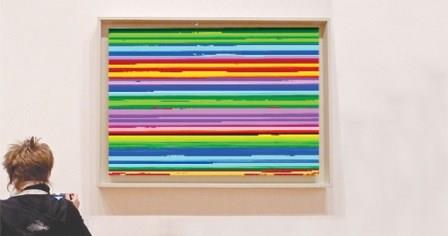The Science of Art
Researchers at the University of Tennessee discover how to turn text into pieces of digital artwork

What do the US Constitution, your car insurance policy, and the human genome have in common? Each one can now be translated into a fabulous work of digital art. All it takes is a sophisticated app created by the unlikely pairing of an artist and a computer scientist.
The concept originated when Amy Szczepanski, assistant research professor of computer science, was tasked with encouraging researchers outside of the traditional hard sciences to harness the power of supercomputers to advance their work.
After seeking advice from UT’s visual arts committee, she struck up a partnership with Evan Meaney, assistant professor of art. Together they decided to explore the gap between data and information through a project dubbed Null_Sets.
“When I worked on glitches and code-breaking in graduate school, I wanted to understand the difference between how computers interpret data versus how we as humans interpret data,” Meaney says.
As humans, we are used to interacting with text in terms of content. When we read a book, we absorb the information and rarely think about the data that makes up that information; the combination of letters that form each word. But words are complicated for computers because each letter is a piece of data to process.
The centerpiece of Null_Sets is a custom software program developed by Szczepanski and Meaney that interprets how computers see human language. The program breaks down whole bodies of text into binary code (ones and zeros) before building it back up into an image.
“The goal of my work with Evan has been to create artistic works,” Szczepanski says. “At the outset, we didn’t have a fixed sense of what form the art would take, but the collaboration was primarily motivated by art.” Their unique blend of art and science eventually yielded digital images open to a variety of interpretations by the human mind.
The color of each piece is actually the most structured part of the process. It is determined through the JPEG standard, a commonly used method of compressing data for digital photography. By displaying a printed collection of these images in a gallery setting, it becomes possible to examine the size and structure of large-scale data sets through an aesthetic lens.
“I always look to the sciences for something beautiful and inspiring,” Meaney says. “I have a very wide interpretation of the word ‘artist’ because there are a lot of avenues that can be used for creation.”
A scientist in a lab, for example, has the same opportunity to create art as a painter does standing in front of a canvas. The difference is that we are not used to thinking about science as art. “Hopefully this research will help to break the idea that science is not art,” Meaney says.
The project is titled Null_Sets because, according to Meaney, they loved the idea of something containing nothing. In mathematics, a null set is a set that does not contain any information. Therefore, a null set makes it possible to explicitly define the results of operations that would otherwise not be explicitly definable.
“Null sets provide an antithetical foundation for there to be something. Our prints are sort of like that,” Meaney says. “At first glance, they look like glitchy cacophonies, but then you realize they actually contain a great deal of data.”
The program was originally written for a supercomputer that allowed them to process huge amounts of text and digitally represent the information at UT’s Remote Data Analysis and Visualization (RDAV) Center. But Meaney and Szczepanski recently adapted the code for desktop computers and now offer an app on their website so anyone can experiment with Null_Sets.
“We are at a point to where the computers on our desks give us the opportunity to engage in science, which provides more opportunities for people to learn and experiment with what they want to do,” Szczepanski says.
What’s up next for Meaney and Szczepanski? Building a documentary using code that can be turned into a film. Until then, take a tour of their website at evanmeaney.com/ns, where you can download the app and create your own Null_Sets masterpiece.
If you need some text, visit the Project Gutenberg website at gutenberg.org. There, you can access free files for such classics as Shakespeare’s Romeo and Juliet or Darwin’s On the Origin of Species by Means of Natural Selection.
Or for those of you who are curious to find out if there is any artistic merit hiding in your car insurance policy, here’s your chance.
Leave a comment